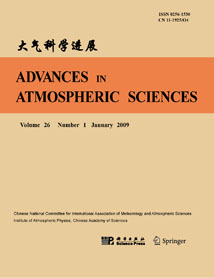| [1] |
Sang Jianguo, Wu Gang,
1987: A NUMERICAL SIMULATION OF FLOW AND CONCENTRATION FIELDS ON MOUNTAIN LEE-SIDE, ADVANCES IN ATMOSPHERIC SCIENCES, 4, 240-247.
doi: 10.1007/BF02677071
|
| [2] |
,
2022: 2022-1 Contents, ADVANCES IN ATMOSPHERIC SCIENCES, , 1-1.
|
| [3] |
,
2023: 2023-1 Contents, ADVANCES IN ATMOSPHERIC SCIENCES, 40, 1-1.
|
| [4] |
,
2024: 2024-1 Contents, ADVANCES IN ATMOSPHERIC SCIENCES, 41, 1-1.
|
| [5] |
ZHU Yali,
2009: The Antarctic Oscillation-East Asian Summer Monsoon Connections in NCEP-1 and ERA-40, ADVANCES IN ATMOSPHERIC SCIENCES, 26, 707-716.
doi: 10.1007/s00376-009-8196-2
|
| [6] |
Feng XUE, Xiao DONG, Fangxing FAN,
2018: Anomalous Western Pacific Subtropical High during El Niño Developing Summer in Comparison with Decaying Summer, ADVANCES IN ATMOSPHERIC SCIENCES, 35, 360-367.
doi: 10.1007/s00376-017-7046-x
|
| [7] |
Feng XUE, Fangxing FAN,
2016: Anomalous Western Pacific Subtropical High during Late Summer in Weak La Niña Years: Contrast between 1981 and 2013, ADVANCES IN ATMOSPHERIC SCIENCES, 33, 1351-1360.
doi: 10.1007/s00376-016-5281-1
|
| [8] |
Chaofan LI, Wei CHEN, Xiaowei HONG, Riyu LU,
2017: Why Was the Strengthening of Rainfall in Summer over the Yangtze River Valley in 2016 Less Pronounced than that in 1998 under Similar Preceding El Niño Events?——Role of Midlatitude Circulation in August, ADVANCES IN ATMOSPHERIC SCIENCES, 34, 1290-1300.
doi: 10.1007/s00376-017-7003-8
|
| [9] |
CUI Xuefeng, HUANG Gang, CHEN Wen,
2008: Notes of Numerical Simulation of Summer Rainfall in China with a Regional Climate Model REMO, ADVANCES IN ATMOSPHERIC SCIENCES, 25, 999-1008.
doi: 10.1007/s00376-008-0999-z
|
| [10] |
Huang Meiyuan, Hong Yanchao,
1984: INHOMOGENEOUS FEATURES IN ME1-YU FRONTAL CLOUD SYSTEM, ADVANCES IN ATMOSPHERIC SCIENCES, 1, 95-111.
doi: 10.1007/BF03187620
|
| [11] |
Kaixu BAI, Can WU, Jianjun LI, Ke LI, Jianping GUO, Gehui WANG,
2021: Characteristics of Chemical Speciation in PM1 in Six Representative Regions in China, ADVANCES IN ATMOSPHERIC SCIENCES, 38, 1101-1114.
doi: 10.1007/s00376-020-0224-2
|
| [12] |
Soon-Il AN,
2018: Impact of Pacific Decadal Oscillation on Frequency Asymmetry of El Niño and La Niña Events, ADVANCES IN ATMOSPHERIC SCIENCES, 35, 493-494.
doi: 10.1007/s00376-018-8024-7
|
| [13] |
Xiao DONG, Jiangbo JIN, Hailong LIU, He ZHANG, Minghua ZHANG, Pengfei LIN, Qingcun ZENG, Guangqing ZHOU, Yongqiang YU, Mirong SONG, Zhaohui LIN, Ruxu LIAN, Xin GAO, Juanxiong HE, Dongling ZHANG, Kangjun CHEN,
2021: CAS-ESM2.0 Model Datasets for the CMIP6 Ocean Model Intercomparison Project Phase 1 (OMIP1), ADVANCES IN ATMOSPHERIC SCIENCES, 38, 307-316.
doi: 10.1007/s00376-020-0150-3
|
| [14] |
Qian Yongfu, Qian Yun, Wang Qianqian,
1994: Numerical Modellings of Properties of the Summer Quasi-Stationary Circulation Systems and Their Monthly Variations, ADVANCES IN ATMOSPHERIC SCIENCES, 11, 399-407.
doi: 10.1007/BF02658159
|
| [15] |
Xuanming ZHAO, Jiang ZHU, Lijing CHENG, Yubao LIU, Yuewei LIU,
2020: An Observing System Simulation Experiment to Assess the Potential Impact of a Virtual Mobile Communication Tower–based Observation Network on Weather Forecasting Accuracy in China. Part 1: Weather Stations with a Typical Mobile Tower Height of 40 m, ADVANCES IN ATMOSPHERIC SCIENCES, 37, 617-633.
doi: 10.1007/s00376-020-9058-1
|
| [16] |
Xuanming ZHAO, Jiang ZHU, Lijing CHENG, Yubao LIU, Yuewei LIU,
2020: An Observing System Simulation Experiment to Assess the Potential Impact of a Virtual Mobile Communication Tower–based Observation Network on Weather Forecasting Accuracy in China. Part 1: Weather Stations with a Typical Mobile Tower Height of 40 m, ADVANCES IN ATMOSPHERIC SCIENCES.
doi: 10.1007/s00376-020-9058-1-bug
|
| [17] |
Wenshou TIAN, GUO Zhenhai, YU Rucong,
2004: Treatment of LBCs in 2D Simulation of Convection over Hills, ADVANCES IN ATMOSPHERIC SCIENCES, 21, 573-586.
doi: 10.1007/BF02915725
|
| [18] |
PING Fan, GAO Shouting, WANG Huijun,
2003: A Comparative Study of the Numerical Simulation of the 1998 Summer Flood in China by Two Kinds of Cumulus Convective Parameterized Methods, ADVANCES IN ATMOSPHERIC SCIENCES, 20, 149-157.
doi: 10.1007/BF03342059
|
| [19] |
LI Weiping, XUE Yongkang,
2005: Numerical Simulation of the Impact of Vegetation Index on the Interannual Variation of Summer Precipitation in the Yellow River Basin, ADVANCES IN ATMOSPHERIC SCIENCES, 22, 865-876.
doi: 10.1007/BF02918686
|
| [20] |
Huang Ronghui,
1985: THE NUMERICAL SIMULATION OF THE THREE-DIMEN-SIONAL TELECONNECTIONS IN THE SUMMER CIRCULA-TION OVER THE NORTHERN HEMISPHERE, ADVANCES IN ATMOSPHERIC SCIENCES, 2, 81-92.
doi: 10.1007/BF03179740
|















 AAS Website
AAS Website 
 AAS WeChat
AAS WeChat 
 DownLoad:
DownLoad: